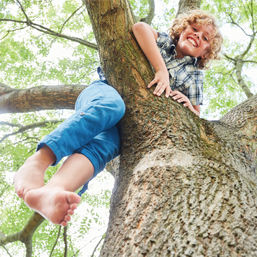
‘Risk’ has almost become a four-letter swear word in our society, especially when it comes to child’s play. But have you stopped to think about what a world without risk is doing to your child’s development?
If your child is never allowed to encounter and engage with risk, they don’t learn how to recognize, manage, or overcome it. They don’t gain the confidence in themselves that contributes to them living a full, well-rounded life. If it comes down to a decision about letting my kid participate in risky play or them never being able to cope with risk, the latter to me is less desirable.
You can understand the benefits of risky play, and still be a little nervous to let your kids engage with it. The first step is to understand the difference between a risk and a hazard. A risk is a challenge or uncertainty in an environment that a person can recognize and learn to manage but choose to engage with it and test their limits. A hazard is a danger in an environment a person can’t recognize that could cause serious injury or harm. A perfect example of this is climbing a tree. Climbing is a risky activity (also fun and fantastic for developing key motor skills!). There is a level of thrill and uncertainty in climbing a tree, but the climber gets to choose how high they climb based on their comfort level. If the climber was to go out onto a rotten branch that they can’t see that could break under their weight, that is a hazard. It’s important to distinguish the difference so when you hear the term ‘risky play,’ you don’t assume danger, and you can start to see the value in it. You can create environments for your child that encourage risk but eliminate hazards.
There are different types of risky play: rough and tumble, play with tools, play at great heights, play with dangerous elements (i.e., fire), play at high speeds, and play where kids ‘disappear’ or get lost. All of these will offer your child a sense of thrill and are guaranteed to help increase physical activity, improve decision-making and social skills, boost resiliency, produce higher self-confidence, and create better risk management. You do not have to do all of these at once. Even one of these types of play will help your child reap the benefits.
A great way to introduce risky play is through spending unstructured play time in nature. Nature provides the perfect environment to help kids learn to interact with risk - hiding behind trees, building forts, climbing over rocks, rolling down hills - while allowing you to feel confident that your kid isn’t encountering hazards. Nature offers incredible loose parts that challenge children to move, build, create, imagine, and play, all while sparking curiosity, increasing focus and attention, improving social-emotional well-being, and reducing stress.
If you were never exposed to risky play opportunities as a child, it can be a little scary to allow your child to do so - and that’s okay! Think about your child’s development, and what they are learning from the experience, not your comfort level with the activity. Your language can be a very powerful tool in risky play; it can help your children, and you, feel more comfortable. When your child is learning, ask them questions to help them assess things, such as, “Is there something you can hold on to?” “Do you feel safe?” “What part of the branch do you think is the strongest?” “Is it slippery/wet/sturdy?” “How are you going to get down?” Conversely, telling your kids to ‘be careful’ disrupts their play, often stopping it. These two simple words are distracting and send the message to your kid that they can’t trust their own instincts; they then hesitate and don’t gain confidence in their own abilities.
Risky play is not a ‘one size fits all’ - it depends on the age, confidence, experience, cognitive and physical abilities of the child as well as the potential consequences of an accident. As the adult, you need to decide what is an acceptable or extreme risk. You would not want your three-year-old to play with an open flame but teaching your school-aged child how to safely light and interact with a campfire is a great skill! Most children have an innate ability to assess risk, and an appetite to engage with it. Children are capable, and they will let you know if they are ready for an activity. Follow their lead, use your judgement, expand your comfort level, and you and your kid can learn to explore and enjoy risky play together.
Sarah has a Bachelor of Physical Education from the University of Alberta and was the supervisor for The City of Calgary’s Mobile Adventure Playground. As the owner of Playful Adventures, she is passionate about bringing back unstructured, loose parts, outdoor play. Reach her at This email address is being protected from spambots. You need JavaScript enabled to view it..
Calgary’s Child Magazine © 2025 Calgary’s Child